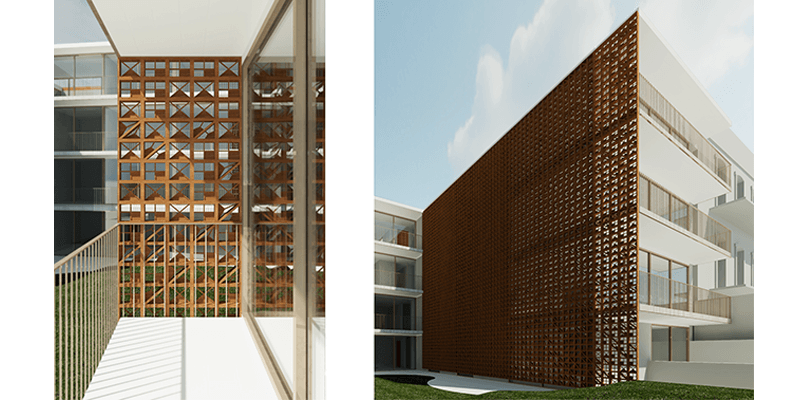An Algorithmic-based Approach for Façade Design
Downloads
DOI:
https://doi.org/10.7480/jfde.2020.2.4543Keywords:
Algorithmic design, Geometric patterns, Fabrication techniques, Facade panelsAbstract
Computation-based approaches are increasingly important in architecture, namely Algorithmic Design (AD), which is based on the use of algorithms to generate designs. Besides enhancing design exploration, AD helps architects deal with recurrent design changes and with the pressure to quickly obtain results. Moreover, AD supports the search for better-performing solutions that satisfy environmental demands. Unfortunately, the complexity and specialized knowledge required by AD are still restraining architects due to the amount of effort and time needed to implement the necessary algorithms. To make AD and design optimization techniques more accessible, we propose a theoretical framework to help architects with the algorithmic generation, evaluation, and manufacturing of a large variety of designs, by following a continuous design workflow that merges the typically detached design stages. In order to be useful, the framework needs to focus on a domain of application, and, in this paper, we target the development of buildings’ façades due to their aesthetical and environmental relevance. We evaluate the framework in the context of a real case study resulting from a collaboration between a team of architects specialized in AD and a traditional design studio
How to Cite
Published
Issue
Section
License
Copyright (c) 2020 Inês Caetano, António Leitão, Francisco Bastos

This work is licensed under a Creative Commons Attribution 4.0 International License.
Authors or their institutions retain copyright to their publications without restrictions.
References
Al-Kodmany, K., & Ali, M. M. (2016). An Overview of Structural and Aesthetic Developments in Tall Buildings Using Exterior Bracing and Diagrid Systems. International Journal of High-Rise Buildings, 5(4), 271–291.
Baper, S. Y., & Hassan, A. S. (2012). Factors Affecting the Continuity of Architectural Identity. American Transactions on Engineering & Applied Sciences, 1(3), 227–236.
Caetano, I., Santos, L., & Leitão, A. (2015). From Idea to Shape, From Algorithm to Design: A Framework for the Generation of Contemporary Façades. In The next city - New technologies and the future of the built environment [16th International Conference CAAD Futures 2015 (p. 483). São Paulo, Brazil.
Chien, S., Su, H., & Huang, Y. (2015). PARADE: A pattern-based knowledge repository for parametric designs. In Emerging Experience in Past, Present and Future of Digital Architecture, Proceedings of the 20th International Conference of the Association for Computer-Aided Architectural Design Research in Asia.
Choo, T.-S., & Janssen, P. (2015). Performance-based parametric design. In Emerging Experience in Past, Present and Future of Digital Architecture, Proceedings of the 20th International Conference of the Association for Computer-Aided Architectural Design Research in Asia (Vol. 1, pp. 1–10).
El Sheikh, M. M. (2011). Intelligent building skins: Parametric-based algorithm for kinetic façades design and daylighting performance integration. Ph.D Thesis. University of Soutern California. https://doi.org/10.1017/CBO9781107415324.004
Erhan, H., Wang, I. Y., & Shireen, N. (2015). Harnessing design space: A similarity-based exploration method for generative design. International Journal of Architectural Computing, 12(4), 217–236. https://doi.org/10.1260/1478-0771.13.2.217
Gibson, I., Rosen, D., & Stucker, B. (2010). Development of Additive Manufacturing Technology. In Additive Manufacturing Technologies: 3D Printing, Rapid Prototyping, and Direct Digital Manufacturing (pp. 19–43). Springer.
Kolarevic, B. (2005). Towards the performative in Architecture. In B. Kolarevic & A. M. Malkawi (Eds.), Performative Architecture: Beyond Instrumentality (pp. 203–214). London, United Kingdom: Spon Press.
Konis, K., Gamas, A., & Kensek, K. (2016). Passive performance and building form: An optimization framework for early-stage design support. Solar Energy, 125(February), 161–179. https://doi.org/10.1016/j.solener.2015.12.020
Leitão, A. (2014). Improving generative design by combining abstract geometry and higher-order programming. In Rethinking Comprehensive Design: Speculative Counterculture, Proceedings of the 19th International Conference on Computer- Aided Architectural Design Research in Asia CAADRIA 2014 (pp. 575–584).
Lin, S. E., & Gerber, D. J. (2013). Designing-in performance: evolutionary energy performance feedback for early stage design. In 13th Conference of International Building Performance Simulation Association (pp. 386–393).
Moneo, R. (2001). The Thing Called Architecture. In C. Davidson (Ed.), Anything (pp. 120–123). New York: Anyone Corporation.
Moussavi, F., & Kubo, M. (Eds.). (2006). The Function of Ornament. Actar.
Nguyen, A.-T., Reiter, S., & Rigo, P. (2014). A review on simulation-based optimization methods applied to building performance analysis. Applied Energy, 113, 1043–1058. https://doi.org/10.1016/j.apenergy.2013.08.061
Otani, M., & Kishimoto, T. (2008). Fluctuating Patterns of Architecture Façade and their Automatic Creation. In CAADRIA 2008 [Proceedings of the 13th International Conference on Computer Aided Architectural Design Research in Asia] (pp. 375–382).
Pell, B. (2010). The Articulate Surface: Ornament and Technology in Contemporary Architecture. Germany: Birkhäuser GmbH.
Picco, M., Lollini, R., & Marengo, M. (2014). Towards energy performance evaluation in early stage building design: A simplification methodology for commercial building models. Energy & Buildings, 76, 497–505. https://doi.org/10.1016/j.enbuild.2014.03.016
Qian, Z. C. (2009). Design Patterns: Augmenting Design Practice in Parametric CAD Systems. SIMON FRASER UNIVERSITY, Burnaby, Canada.
Rytel, G. (2013). The Influence of Climate on the Forms of Brazilian Modernist Archiecture in the Years 1925-1960. Kwartalnik Architektury I Urbanistyki, 4, 57–78.
Schittich, C. (Ed.). (2006). Building Skins. Birkhäuser. https://doi.org/10.11129/detail.9783034615082
Schulz, C. N. (1971). Existence, space & architecture. New York: Praeger. Stamps.
Sousa, S., & Batista-Bastos, M. (2015). O tempo e a Diferença: Análise e Readaptação num Edifício em Lisboa [Time and Difference: Analysis and Readaptation in a Building of Lisbon]. Cadernos de Arquitectura e Urbanismo, 22(33), 58.
Stojšić, M. (2017). (New) Media Façades: Architecture and/as a Medium in Urban Context. AM Journal, (12), 135–148. https://doi. org/10.25038/am.v0i12.173
Venturi, R., Brown, D. S., & Izenour, S. (1972). Learning from Las Vegas. MIT Press.
Woodbury, R., Aish, R., & Kilian, A. (2007). Some Patterns for Parametric Modeling. 27th Annual Conference of the Association for Computer Aided Design in Architecture, 222–229. Retrieved from http://moodle.ncku.edu.tw/file.php/2687/assignments/ ParametricPatterns.pdf
